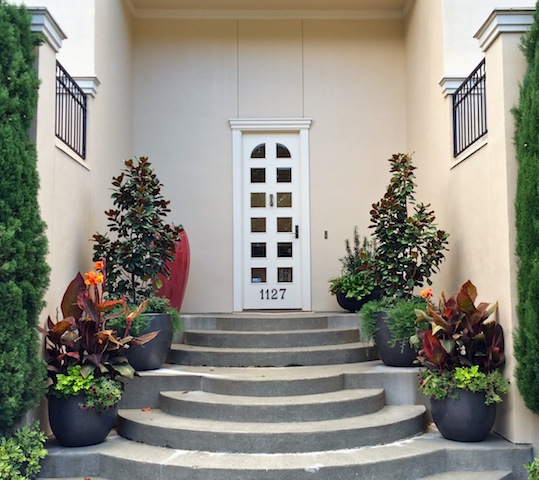
Design is primarily problem solving. The creative process begins with defining solutions in the context of a comprehensive plan. The artifice is making it visually interesting and aesthetically valuable.
As elements of a landscape design, container gardens are much more than decorative accessories. Potted plants and trees can not only solve design problems but create new opportunities.
This post looks at a few ways you can use containers to enhance the appearance of your landscape—and gain access to a wider selection of plants.
Potted plants and trees as problem solvers
Problem: Poor soil quality—rock, clay, or compacted ground filled with roots of surrounding trees or plants
Solution: Containers provide a vessel for a rich planting medium that will not be infiltrated by weeds or roots of surrounding trees. A wide selection of plants will be able to thrive.
Problem: Dry soil. Compacted earth or sloped areas allow water to run off without penetrating the roots of plants. Areas under trees don’t get adequate rain. Fast draining, rocky or sandy soil fails to retain moisture.
Solution: With containers, it becomes easy to control and monitor moisture levels, taking the guesswork out of watering. If the slope is gentle, a group of containers in a level area adds interest when viewed from below. Easy-to-water containers enable a wider plant selection.
Problem: Lack of garden space.
Solution: Container gardens provide planting space for rooftops, balconies, hardscapes, and other spots where you couldn’t otherwise grow plants.
Container gardens as design elements
You can use containers to:
- Mark an entrance, define a pathway and add a colorful welcome.
- Create focal points in prominent locations or when placed in sight lines.
- Provide temporary interest in an area that’s past its prime or hasn’t reached it yet.
- Make it possible to move semi-hardy or tender plants to a protected area during the winter.
When planning a container gardener or selecting a pre-planted one, determine where your containers will go and how they will be seen. Here are some guidelines:
- Pots viewed from one side should have larger plants in the back.
- Pots viewed from all sides should have taller plants in the center.
- Select a composition of plants that will not rely on flowers alone to stay looking fresh.
- Vary leaf shape, color and size for textural contrast and interest.
- When using multiple containers, include unifying features. Use similar pots, a related color scheme or repeat a plant or two to create a cohesive look.
More ideas
With spring coming up, revitalizing your container gardens is a great way to welcome the season!
If you’re looking for more ideas, please contact me for a design consultation to learn about landscape design or how to maximize the impact of plantings for any spot in your garden.
